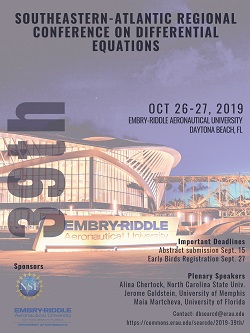Institution
University of Miami
Abstract
Roughly speaking, a population is said to have an ideal free distribution on a spatial region if all of its members can and do locate themselves in a way that optimizes their fitness, allowing for the effects of crowding. Dispersal strategies that can lead to ideal free distributions of populations using them have been shown to exist and to be evolutionarily stable in a number of modeling contexts in the case of habitats that vary in space but not in time. Those modeling contexts include reaction-diffusion-advection models and the analogous models using discrete diffusion or nonlocal dispersal described by integro-differential equations. Furthermore, in the case of reaction-diffusion-advection models and their nonlocal analogues, there are strategies that allow populations to achieve an ideal free distribution by using only local information about environmental quality and/or gradients. We show that in the context of reaction-diffusion-advection models for time-periodic environments with spatially varying resource levels, where the total level of resources in an environment remains fixed but its location varies seasonally, there are strategies that allow populations to achieve an ideal free distribution. We also show that those strategies are evolutionarily stable. However, achieving an ideal free distribution in a time-periodic environment requires the use of nonlocal information about the environment such as might be derived from experience and memory, social learning, or genetic programming. This is joint work with Chris Cosner.
Evolutionary Stability of Ideal Free Dispersal under Spatial Heterogeneity and Time Periodicity
Roughly speaking, a population is said to have an ideal free distribution on a spatial region if all of its members can and do locate themselves in a way that optimizes their fitness, allowing for the effects of crowding. Dispersal strategies that can lead to ideal free distributions of populations using them have been shown to exist and to be evolutionarily stable in a number of modeling contexts in the case of habitats that vary in space but not in time. Those modeling contexts include reaction-diffusion-advection models and the analogous models using discrete diffusion or nonlocal dispersal described by integro-differential equations. Furthermore, in the case of reaction-diffusion-advection models and their nonlocal analogues, there are strategies that allow populations to achieve an ideal free distribution by using only local information about environmental quality and/or gradients. We show that in the context of reaction-diffusion-advection models for time-periodic environments with spatially varying resource levels, where the total level of resources in an environment remains fixed but its location varies seasonally, there are strategies that allow populations to achieve an ideal free distribution. We also show that those strategies are evolutionarily stable. However, achieving an ideal free distribution in a time-periodic environment requires the use of nonlocal information about the environment such as might be derived from experience and memory, social learning, or genetic programming. This is joint work with Chris Cosner.

